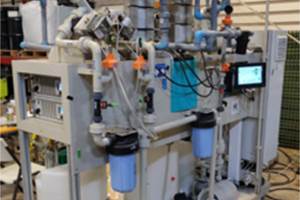Parts Drying Using Natural Media
Toledo Deburring has dried parts the same way for more than 15 years. Why fix it, if it isn't broken? . . .
Late in 1995, Toledo Deburring Company passed an important milestone when its annual parts volume topped the 100-million mark for the first time. Toledo Deburring, and its Livonia, Michigan, sister company, The Deburring Company, finish ferrous and non-ferrous stampings for automotive, medical/dental, luggage and appliance manufacturers.
Toledo Deburring is true to its name, and much more. In addition to deburring, the company performs vibratory cleaning and polishing, abrasive blasting, tumbling, degreasing, a three-part de-rust/abrasive finish and blast operation, and some glass bead and plastic media paint stripping.
President Robert Van Schoick engineered the expansion that tripled Toledo's volume and customer base in just three years. As part of that plan, he examined every step and product used in both facilities. As a result, many aspects of the operation changed.
Conversion to all-aqueous cleaning is one notable example, as is the addition of some plastic media processing. Obtaining ISO 9000 registration, and instituting company-wide JIT (all parts are shipped in 24-48 hrs) were other important changes.
One thing that has remained unchanged since the early 1980's is parts drying. Parts exit a tumbler or vibratory finisher coated with a soap and rust-inhibiting oil. Water must be quickly eliminated to avoid spotting. Residual contaminants are isolated and the rust inhibitor is evenly re-deposited.
Two machines, a Rotofinish (vibratory) Spiratron and a Ransohoff tumbler/dryer, are used. The media used in both systems is Grit-O-Cobs®, a corncob product developed and manufactured by The Andersons, Maumee, Ohio.
Parts are dried in the Spiratron for five to 10 min and for 30 min in the tumbler/dryer. The corncob media acts like a sponge. It pulls contaminants away from the parts, evaporating the water, and distributing the rust-inhibiting oil evenly over the surface. The soft surface of the corncob media cushions the parts against damage during processing.
The corncob media also has consistent particle sizing. Mr. Van Schoick explained, "If media particle size varies, it adheres in the slots and threads, and accumulates in passageways." To complicate matters, all vegetable-based media swells when it contacts water. Thus, it is important that particle size be consistent, as with corncob media.
The corncob media is manufactured from commercial ear corn as well as hybrid varieties. Milling equipment progressively separates the components by grinding, air classifying and screening. Particles are separated and sized through aspiration and screening.
Seven commercial grades (and a few proprietary grades) are available, with granules ranging in size from ¼-inch to a material similar to fine powder. Applications range from drying to grit blasting. Often, corncob media is used as a blending media with other materials to add volume, extend service life and reduce costs.
Toledo uses two corncob sizes, each sized to dryer specifications. Product life is estimated at 40 to 80 dryer hrs, depending on the condition of loads as they are received from stampers.
Whether the application is drying or blasting, the corncob media remains virtually dust free. It is also all-natural and biodegradable; therefore it does not present an environmental problem. Notably for Toledo Deburring, the waste product is dry, so it is more manageable and less voluminous than wet waste generated by aqueous washers and other systems used to perform the same task.
Using corncob media in a 150F dryer is less costly than processing without media because of the hotter temperatures and longer cycles that are needed when no media is used.
It is also worth noting that there are three ways to prevent water spotting: deionized water, hand buffing or corncob media. Of these, corncob media is the most cost-effective for Toledo Deburring. Corncob media also adds luster to the parts.
Related Content
TTX Environmental Solves Customer Issue with Electro-Ceramic Desalination Wastewater Processing
Electroplating facility without access to a drainage system found a safe solution for wastewater treatment and reuse.
Read MoreTop Reasons to Switch to a Better Cleaning Fluid
Venesia Hurtubise from MicroCare says switching to the new modern cleaning fluids will have a positive impact on your cleaning process.
Read MoreAlkaline Cleaning Guide
Gregg Sanko, Senior Chemist, Oakite Products, Inc. provides an overview of the alkaline cleaning process.
Read MoreCorrosion Resistance Testing for Powder Coating
Salt spray can be useful to help compare different pretreatment methods and coatings but it does not tell us much about the corrosion resistance of a part over time in the field. Powder coating expert Rodger Talbert offers insights into how to get a better idea of how to improve a part’s corrosion resistance in the real world.
Read MoreRead Next
A ‘Clean’ Agenda Offers Unique Presentations in Chicago
The 2024 Parts Cleaning Conference, co-located with the International Manufacturing Technology Show, includes presentations by several speakers who are new to the conference and topics that have not been covered in past editions of this event.
Read MoreEducation Bringing Cleaning to Machining
Debuting new speakers and cleaning technology content during this half-day workshop co-located with IMTS 2024.
Read MoreEpisode 45: An Interview with Chandler Mancuso, MacDermid Envio Solutions
Chandler Mancuso, technical director with MacDermid Envio discusses updating your wastewater treatment system and implementing materials recycling solutions to increase efficiencies, control costs and reduce environmental impact.
Read More





















